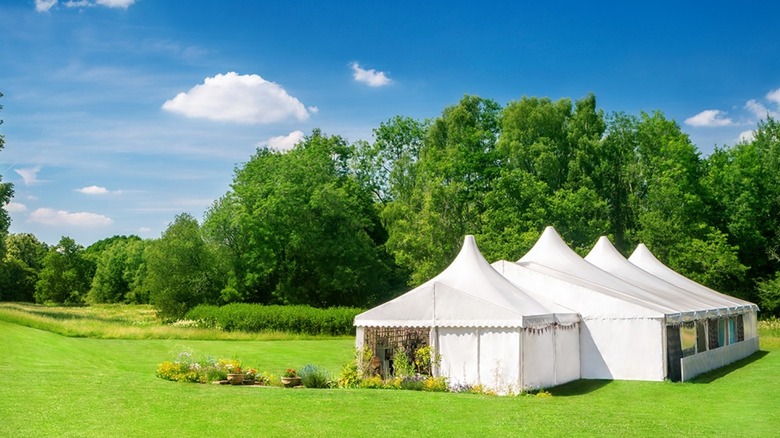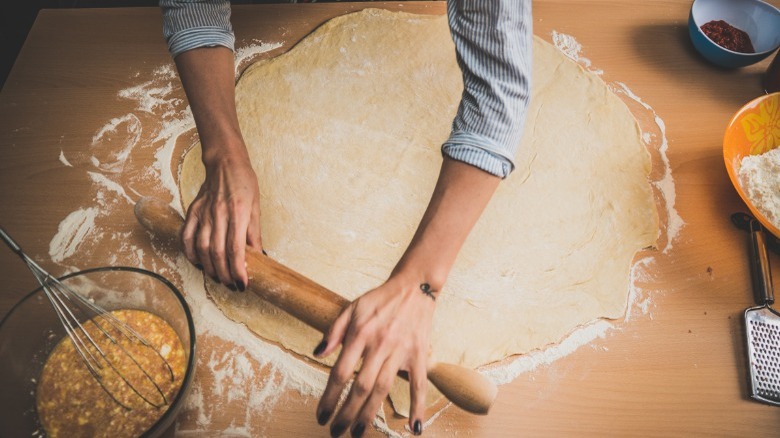Ever Wonder Why The Great British Bake Off Is Filmed In A Tent?
On every episode of "The Great British Bake Off," scenes of classic dishes like English Eccles cakes and chatter amongst bakers are interspersed with shots of the British countryside surrounding all the buzz. If you've been paying close enough attention to the setting, you likely have noticed that each challenge takes place within a big (and expertly decorated) white tent. But have you ever really wondered why?
As it turns out, the tent idea was first pitched by one executive producer, Anne Beattie, who thought that it would round out the aesthetic they were pursuing for the show. The goal was to have viewers and bakers alike feel as though they were immersed in a village fête — similar to a farmer's market but with games and tea — where all around them an assortment of jams and baked goodies were being sold and indulged in.
For two of the show's iconic judges, Prue Leith and Paul Hollywood, the tent provides that extra challenge that bakers wouldn't get in a controlled environment like an indoor kitchen. In the tent, the weather, humidity, insects, and other natural elements come into play and act as yet another roadblock that bakers must overcome before they can claim the coveted prize — making the show even more entertaining for viewers as well.
Why are the elements such a challenge for bakers in the GBBO?
Everyone enjoys a little fresh air, but when baking, the outdoors can actually have a major impact on the kind of results you can achieve, which puts even more pressure on "Bake Off" contestants. One big factor that impacts the competition is humidity. Humidity has an impact on things like density, moisture level, and the ability to rise in baked goods. Powdered ingredients like flour and baking soda are hygroscopic, which means they take on the air's moisture. When it is humid, this additional liquid alters these dry ingredients, making them lumpy and hard to work with.
"The Great British Bake Off" is also known for challenging bakers to pull off super technical tasks — for example, meringue. Goods like meringue require the right ratio of sugar to egg white to achieve their stiff peaks, but extra moisture in the air can be absorbed by the sugar, altering this balance. Additionally, although the fermentation and rising of dough may actually benefit from the extra humidity, too much isn't good either and can potentially cause too-soft or sticky yeast-based doughs.
Ideally, the humidity in a baking-friendly environment should be between 40 and 60%. But, "Bake Off" is filmed between April and June in the British countryside where the climate is typically mild to warm with a mixture of sunny and rainy days — and often, even on sunny days, the air can be quite humid.
How can you beat the heat in your kitchen?
You may not be outdoors crafting dishes as technical as raspberry pavlova like the "Bake Off" chefs, but temperature can still impact you in the kitchen. Luckily, there are methods to mitigate its effects.
When working with cookie dough or buttery pie crust, warmer ambient temperatures can melt fat, making dough crumbly while impacting the ability of cookies to rise. One way to combat this is by placing ice packs on your countertop to make sure it's as cool as possible before you start rolling out dough. Additionally, if you know you're in for a steamy day, try baking in the morning before it gets too warm outside (and in your kitchen).
Cooling your kitchen tools can also help. If you're considering making whipped cream, chilling your metal mixing bowl and whisk or beaters in the freezer beforehand will allow you to get more volume in the cream in less time. Also, consider adding tangy Greek yogurt to stabilize your cream and prevent falling.
We know humidity impacts dry ingredients, so to prevent clumping, try storing them in your fridge or freezer. Placing flour in an airtight container in a cool, dry environment not only ensures it doesn't get lumpy but will also help it stay fresher and keep pests away. Keep in mind that if you do try this, you'll have to bring the flour back to room temperature before you bake — especially for yeast doughs that rely on fermentation.



